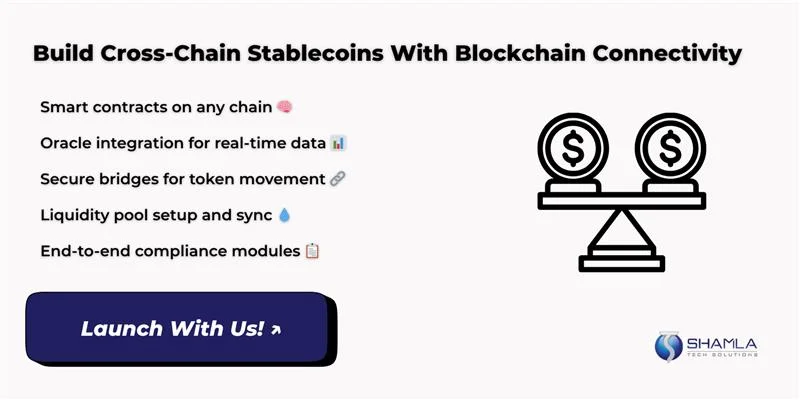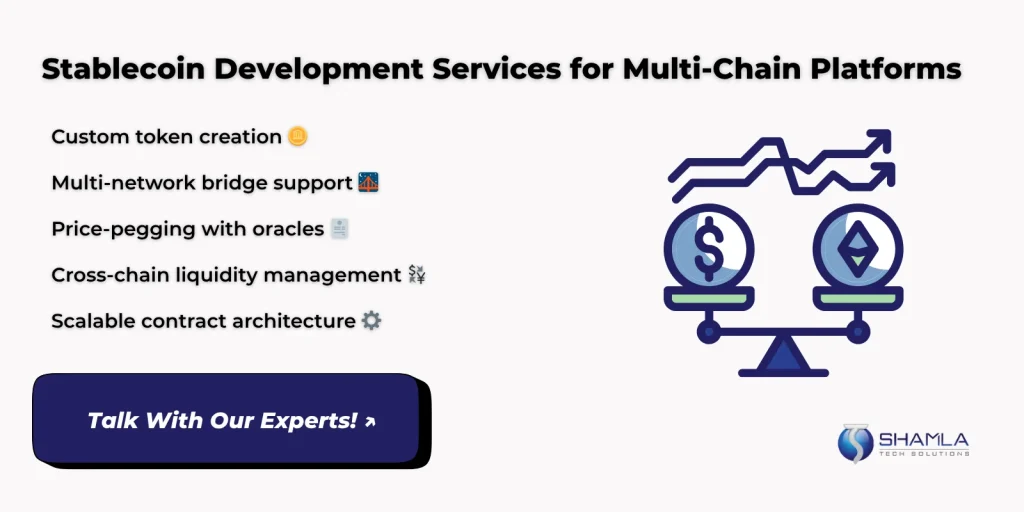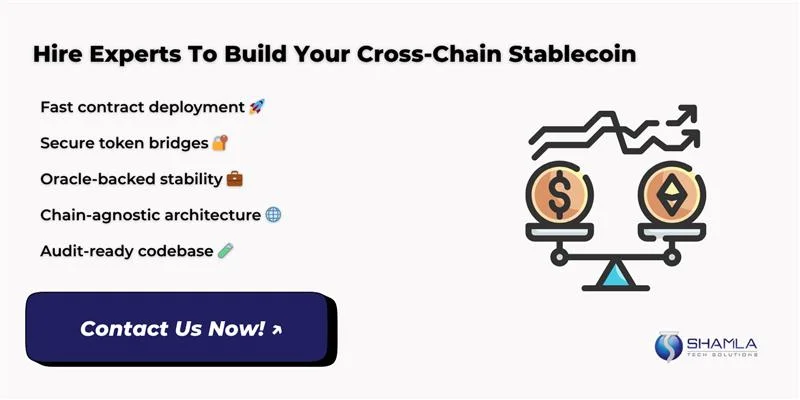Why Cross-Chain Stablecoins Matter for Blockchain Interoperability
1. Single‑Chain Limits and Fragmented Liquidity
2. Bridges, Wrapped Tokens, and Secure Transfers
3. Unified Access to Global Markets
4. Varieties, Minting, and Basic Mechanics
There are several types of stablecoin: fiat‑backed, crypto‑collateralized, and algorithmic. To maintain value peg, most projects follow a clear process for how stablecoins are created: users deposit collateral into a smart contract, which then mints tokens at a fixed ratio. Redeeming reverses the flow. Interoperable stablecoins add a layer that tracks ownership proofs across chains, ensuring that each token stays backed as it moves. Cross‑chain stablecoin solutions embed this mint‑burn logic into every network’s contracts, so supply stays accurate everywhere.
5. Regulatory Clarity and Multi‑Chain Trust
Top Cross-Chain Stablecoin Solutions in the Market
1. USDC: A Multi‑Ledger Anchor
2. DAI: Decentralized Collateral Model
DAI stands out among cross‑chain stablecoin solutions by using crypto collateral instead of fiat. As a cross‑chain stablecoin, it bridges Ethereum, Polygon, and Arbitrum through decentralized vaults and wrapped token contracts. Each DAI unit ties to locked collateral via MakerDAO’s smart contracts, and trusted relayers oversee mint‑burn actions across ledgers. This model keeps DAI in the list of top 10 stablecoins and boosts transparency. Key features include:
- Collateral monitoring to enforce over‑collateral ratios
- Automated auctions for under‑backed positions
- Governance votes that adjust parameters
With DAI’s peer‑driven system, users can move stable value freely while maintaining strong on‑chain assurances.
3. Tether’s Multi‑Network Expansion
4. USDX: Automated Cross‑Chain Minting
USDX illustrates modern cross‑chain stablecoin solutions with a fully decentralized mint‑burn engine. As interoperable stablecoins, USDX tokens deploy on networks like Cosmos and Ethereum using IBC and Wormhole protocols. Their contracts use light‑client proofs to confirm events across chains, avoiding single‑keeper vaults. Key mechanics:
- On‑chain proofs that validate locks on the source chain
- Autonomous relayer jobs that trigger token issuance
- Emergency halt flags for rapid response to threats
By embracing decentralized stablecoin development, USDX keeps supply synced and lowers trust needs. Builders get a ready codebase for cross‑chain minting, cutting integration work.
5. USDN: Near‑Protocol’s Stable Link
USDN offers cross‑chain stablecoin solutions originating on Near Protocol and extending via Rainbow Bridge to Ethereum. This cross‑chain stablecoin uses NEAR tokens as collateral, managed by on‑chain validators. When a user locks NEAR, the system mints USDN on Near first, then routes to Ethereum via light‑client proofs. Projects appreciate clear mint‑burn flows and fast cycle times. Key cost of stablecoin development factors here include:
- Validator staking setups for collateral security
- Bridge maintenance fees per transaction
- Oracle integration for price feeds
USDN’s open code lets teams estimate expenses and launch mirrors on new chains with minimal tweaks.
6. LUSD: Liquity’s No‑Fee Model
LUSD enters cross‑chain stablecoin solutions by using Liquity’s protocol on Ethereum and Arbitrum. It mints tokens without fees when users stake ETH over a 110 percent ratio, then moves LUSD across chains via Hop Protocol. This design skips long swaps by using shared liquidity pools and instant relays. Projects benefit from:
- Zero‑fee issuance reducing user costs
- Automatic collateral checks to keep pegs stable
- Shared relay pools that minimize delays
LUSD’s approach provides a simple path for apps to add stablecoin support without running their own bridge code. Developers can plug LUSD into DeFi services and tap cross‑chain value instantly.
Building Cross-Chain Stablecoins: Tech, Costs & Services
1. Smart Contracts & Token Mechanics
2. Oracle Integration & Data Feeds
3. Liquidity Pools & Compliance
4. Bridges, Providers & Dev Support
5. Team & Talent Acquisition
Conclusion
Cross-chain stablecoin solutions power smooth, instant, efficient, scalable value moves across networks and form the backbone of interoperable DeFi and payment systems. A cross-chain stablecoin links liquidity pools, cuts user steps, and secures transactions across chains, removing friction and opening new use cases in global lending, trading, and worldwide remittances.
Shamla Tech is a stablecoin development company offering complete stablecoin development solutions, from code to bridge setup. Our team builds secure oracles, liquidity modules, and robust compliance checks. If you need to hire stablecoin developers for design, audit, and deployment steps, partner with us for a fast, reliable, efficient launch.
Ready to launch your cross-chain stablecoin?
Contact us to get started today!
FAQs
1. What are cross-chain stablecoin solutions?
2. Why are cross-chain stablecoins important for DeFi?
Cross-chain stablecoins let DeFi platforms tap shared liquidity across networks, reducing trade delays costs. They power borrowing, lending, and yield farming with tokens. This seamless liquidity fuels faster cheaper protocols.





